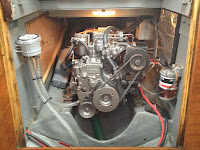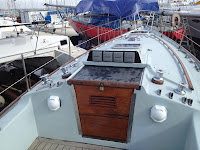The first couple of days were not promising with gales all along the south coast but they were forecast to give way to a ridge of high pressure and a period of stable weather, which would be ideal - if it happened.
Living on board with just two of us is quite a luxury now that we've got everything organised; some of the less attractive aspects such as the lack of storage and space in the heads don't matter so much . The new galley works really well, especially the fridge which swallowed up an enormous amount of food for the week. It was a shame in a way that the days are so long at this time of year as the oil lamps make the saloon so inviting when it eventually grows dark in the evening. Fortunately we've found plenty of room to keep our walking gear under the bunks in the forepeak so spent the first day walking followed by a relaxing evening enjoying a steel band that was playing at the club.
Monday dawned and amazingly for us the wind had moderated, as forecast, to a force five so we could set off for Cowes. Even the tides cooperated with high tide at mid day so we didn't even have to get up early, and with a full spring tide we'll get away quickly. The little Yanmar engine started first time and we were soon through the lock which was in free flow and motored down past Ichenor to East head and out to sea. We'd put a reef in the mainsail to kept her stable and she slid easily through a rough patch over the bar into clear airs. With the genoa up we could see how she really performed in a 20-25kn northwesterly, this was no disappointment! We were soon beating over to Bembridge in the company of a rather larger racing yacht and a similar size Westerly. Amazingly we held onto the racing yacht whilst the Westerly sagged down wind of us, going to windward had become enjoyable again!
 After a quite exhilarating sail through the forts and past Osborn Bay we came up to Cowes just before the tide was about to turn. What had been really noticeable was how easy she was to helm, light but responsive, very different from what we'd been use too, it certainly had Lynda's approval! It's always great to spend a night in Cowes and this was no exception, just the way to spend the first night away from home.
After a quite exhilarating sail through the forts and past Osborn Bay we came up to Cowes just before the tide was about to turn. What had been really noticeable was how easy she was to helm, light but responsive, very different from what we'd been use too, it certainly had Lynda's approval! It's always great to spend a night in Cowes and this was no exception, just the way to spend the first night away from home.The following day the wind had really dropped off with only about five knots most of the time so after shopping around for the many bits of safely gear we lacked we set off for Yarmouth. We had expected to motor all the way and in bright sunshine, it was not hard to tolerate. A gentle motor across the western Solent past Newtown River was very pleasant and a good way of building up confidence in the engine anyway. With only a bit of throttle, she motored at a steady 5kn making little noise even though there was no sound insulation installed yet.
Once we'd rounded the pier the harbourmaster came out and escorted us to an alongside berth; such a luxury, thanks to being out of season. With shore power connected up we were able to keep the wine and beers cold so able to enjoy a couple of sundowners to mark the end of a wonderful sunny, summers day.
As it was all just too good to miss we decided to have a lay day and booked in for two nights enabling us to have a fine walk over Tennyson Down the following day with it's glorious views over the Needles and the Solent. We'd found an excellent delicatessen in Cowes so ate well that night on board; the cooker had proved itself too!
Time to move on and Buckers Hard the choice, without much wind it was time to relax rather than try to be too ambitious. We tried to sail but even the Contessa's hull, that was so easily driven, failed to make much progress so it had to be the iron sail again. It's not far over to the other side and into the Beaulieu river so it didn't take long and we were soon safely moored up at Bucklers Hard. It was like old times motoring up the river past our old mooring and Ginns Farm where we'd had so many enjoyable evenings. Another lay day was called for and despite a band of rain passing thorough we enjoyed a walk up to Beaulieu for lunch.
It was quite a wrench leaving such a pleasant stopover the next day, all the more so as there was a food fair in the grounds of the Master Builders Arms which we couldn't miss. Although we ended up with late start we had a brisk, favourable wind to take us home, a good15 knot southerly. With full sails set we had a fine sail past Portsmouth in perfect conditions. Just for a change we let the autohelm take over for much of the time to get used to it and found that it also performed rather well even though it's one of the few bits of of original equipment and considered rather suspect. After several days of fiddling I'd managed to master the plotter and instruments which all worked well except that there was no way that we could display the bearing and distance to the next waypoint, it was only shown on the plotter down below, a minor incovienience.
After a fast passage we arrived just before high water, went straight though the lock and moored up in time for tea; very civilised! After a week on board it felt that all the hard work and expense of restoration just might have been worth while. What was particularly satisfying was the number of very favourable comments made by those passing by, there are clearly many closet Contessa lovers out there who envy her sailing characteristics but have chosen a more conventional, more modern, yacht with greater accommodation. For us anyway, the ease of handling and splendid sailing more than make up for the compromise made on space in a marina.






































